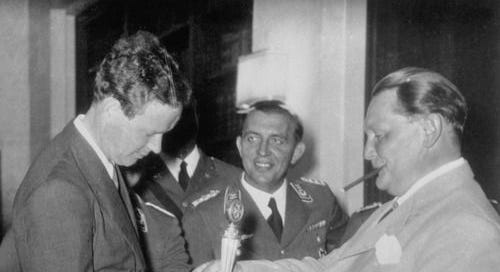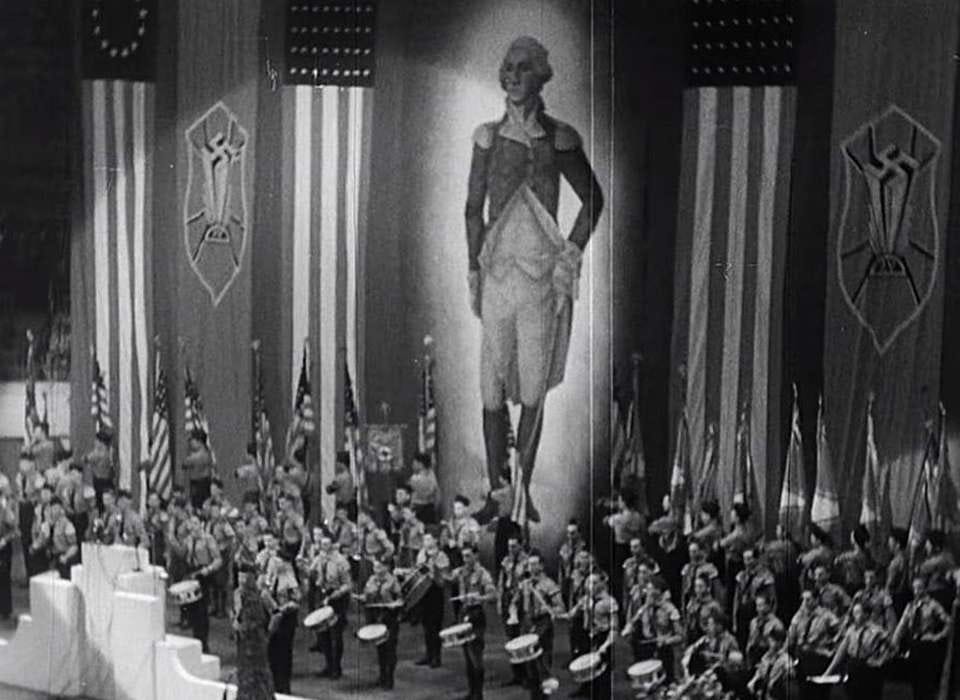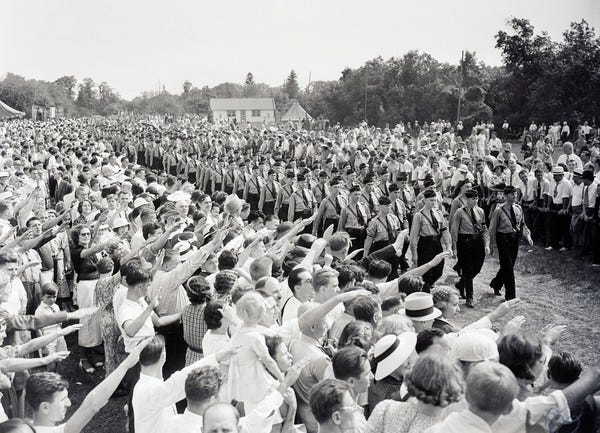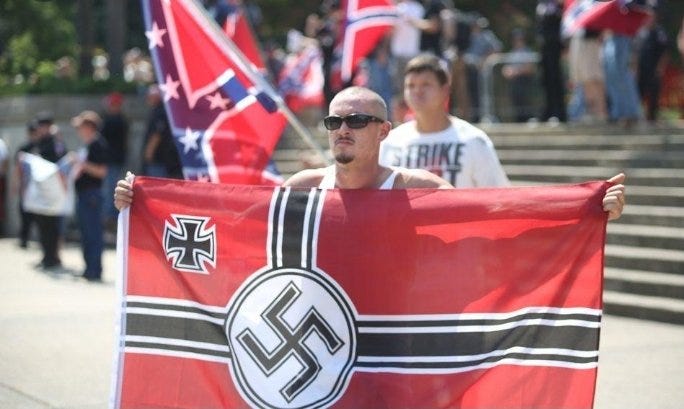Lindbergh, The Wall St Putsch, and American Fascism
It already happened here and it is happening again right now
Excerpt from Civil Wars II: From Insurrection to Insurgency
GETTY IMAGES - Lindbergh receiving Nazi Cross from Herman Göring
America fared better than other countries immediately after WWI. The 1929 crash changed all that. The widespread suffering and panic triggered by the great depression made American society as vulnerable to extremism as any other.
America had hit rock bottom, beginning with the stock market crash three years earlier. Unemployment was at 16 million and rising. Farm foreclosures exceeded half a million. More than five thousand banks had failed, and hundreds of thousands of families had lost their homes. Financial capitalists had bilked millions of customers and rigged the market. There were no government safety nets – no unemployment insurance, minimum wage, social security or Medicare.
The greatness of FDR’s leadership and the importance of the New Deal in helping to pull America out of the great depression is an article of faith today. In the 1930s, it was not so clear cut. In fact, America had a pretty serious fascist problem. A popular and rapidly growing movement with as many as 150,000 uniformed members in a variety of organizations (some armed). Assuming a 1:3 ratio of uniformed to direct supporters, that would put the number of American fascists at ~450,000. They were unified in their hatred of FDR - “This is despotism! This is tyranny!”
The direct threat to the president was real. Just sixty eight years after Lincoln was shot from behind, it was not unusual to hear a respectable citizen say at a Washington dinner party “What that fellow Roosevelt needs is a 38-caliber revolver right at the back of his head.” This was no idle dinner party banter. FDR had narrowly survived an assassination attempt just weeks before his first inauguration in 1933. Had it been successful, who knows how different history would have turned out. Nor was this the only plot to destroy FDR.
Video of assassination attempt.
Of all American fascist movements, the best known was the German American Bund which was America’s nazi party. They portrayed themselves as American as apple pie. Most famously, they celebrated George Washington’s birthday, February 20, with a huge rally at Madison Square Garden in 1939, just months before Hitler ignored the final ultimatum and invaded Poland. The meeting proudly proclaimed Washington as "America's first fascist". Washington gazed on the crowd from center stage in a massive flowing banner mounted between huge swastikas that were right-sized for a rally at Nuremberg. Gerhard Wilhelm Kunze reminded the crowd that "the spirit which opened the West and built our country is the spirit of the militant white man… It has then always been very much American to protect the Aryan character of this nation”. Twenty thousand nazis in uniform standing in ranks listened as their Bundesführer, Fritz Kuhn, denounced ”Frank D. Rosenfeld’s” (sic) “Jew Deal” (sic) as a communist plot.
This was a remarkable moment in American history. It reflected considerable support for the movement. Travel was not frictionless in 1939. The only option was the railway. Bringing together 20,000 uniformed storm troopers in one location was a significant statement. These were not all citizens of New York. Nazi’s had come from all over the country, carrying black uniforms, banners and flags, ready to support their führer. American nazis had a substantial organization and sophisticated operation including training camps spread around the country. This photo essay takes you into the operation. Having a mass American nazi movement no doubt became a bit of an embarrassment after Hitler declared war on America and millions of GIs shipped out to go house to house fighting nazi’s in Europe.
Nazi’s were the most obvious manifestation of the rise of fascism in America, but they were far from alone. Fascist ‘militias’ formed all over the country with memberships totaling in the tens of thousands. They shared the nazi’s hatred of FDR. Like the Brown shirts in Germany and Mussolini’s black shirts, US fascists adopted similar attire and names. There were many groups, but two resonate with the contemporary period. The Grey shirts, whose core objective was to remove “Communist college professors”. While the “Silver Shirts was an apocalyptic Christian militia patterned on the notoriously racist Texas Rangers, that operated in 46 states and stockpiled weapons”, according to Sally Denton, author of The Plots Against the President.
American sympathy towards the nazi’s was not limited to the storm troopers of the German-American Bund and other fascist militia. It reached high up into the ranks of elite society. Henry Ford received the Grand Cross of the Order of the German Eagle for his publication of The International Jew. His book was a collation of essays extracted from the company newspaper distributed at his vehicle manufacturing plants. His most avid reader was a failed painter in southern Germany named Adolf Hitler. Ford’s explanation that Germanys interwar ills were the responsibility of the Jews found a welcome home in Hitler’s world view. “The Jew hated the German people” Ford wrote. “Jewish hands were in almost exclusive control of the engines of publicity by which public opinion concerning the German people was molded. The sole winners of [WWI] were Jews“. Hitler gave Ford something even more valuable than the Grand Cross. He mentioned Ford by name in the text of Mein Kampf. Hitler wrote “Ford, to their fury…[was the] only.. single great man” to stand up to American Jews.
Ford was far from a lone wolf. His close friend, Charles Lindbergh, was slightly more guarded in his speech, but his anti-semitism pierced the thin veil. Lindbergh was the first person to fly solo between New York and Paris in 1927. Aviation had captured the public imagination and this triumph made Lindbergh a household name world wide. His aircraft, the Spirit of St Louis, is suspended from the ceiling of the Smithsonian a few miles from where I am writing. What he did with his fame is a matter of considerable controversy.
Lindbergh became what we today would call an ‘influencer’. Indeed, in the 1930s he was the ultimate influencer. Had twitter existed, he would have more followers than all the Kardashians combined. His fame was of a similar character, in that a daring feat of aviation somehow translated into a global platform to espouse views on matters outside of his expertise. Radio was the medium of the moment and he had everyones ear. In one famous broadcast he explained to his listeners that Jews own and influence the US government. “[The Jew’s] greatest danger to this country lies in their large ownership and influence in our motion pictures, our press, our radio and our government.” Evidentially, Jewish control of the radio did not extend to censoring Lindbergh. In other parts of the speech and others like it, he always added that he liked and admired those he saw as America’s enemies. A clever rhetorical trick to be able to say norm-busting things under a thin veneer of free speech and reasonableness.
Testifying before Congress against the Lend-Lease bill in January 1941, Lindbergh explained his belief in the moral equivalency of Britain to nazi Germany. “There is not as much difference in philosophy as we have been led to believe,” he said. This was after Germany had invaded and occupied all of western Europe. To Lindbergh, the fight between Britain and Germany was not one in which the United States ought to have a position, “I am in sympathy with the people on both sides”.
Lindbergh implored the Congress to leave Britain alone “to wage war against a monstrous tyranny, never surpassed in the dark lamentable catalogue of human crime” as Churchill famous described his adversary just months before Lindbergh’s testimony. Lindbergh told Congress that the only way to guarantee American security was to negotiate a neutrality pact with nazi Germany. At the time, isolationism was a long standing and highly popular policy. It remained so until Dec 7, 1941.
Parenthetically, of Lindbergh’s strategic acumen the following should be noted. In 1924 military aviation visionary Billy Mitchell had predicted a future Japanese attack on Pearl Harbor combined with a simultaneous assault on the Philippines. He estimated the best time to attack would be at 730am on a Sunday morning. In the end, either he, or the attackers, were off by 25 mins. By contrast, in October 1940, Lindbergh declared that “no nation in Asia has developed their aviation sufficiently to be a serious menace to the United States at this time.”
The problem with Lindbergh’s position on bowing to Hitler was that he came to it not entirely from a position of personal neutrality. He followed in the footsteps of the abdicated British King, touring Germany in 1938 as an honored guest (and propaganda stooge) of the nazi’s. His award of the very same Grand Cross of the Order of the German Eagle given to his dear friend, Henry Ford, was personally bestowed upon Lindbergh by Germany’s most famous aviator, Herman Goring. Nazi hospitality had convinced Lindbergh to move to Berlin. He was mid-negotiation on a property there when Kristallnacht made him think the better of it. Evidentially, having good people on both sides of Kristallnacht was insufficient incentive to keep him in Berlin.
It was while Hitler was escalating his conquests in the run up to the invasion of Poland, that Lindbergh decided it was time to come home and put America first. He did this by becoming the spokesman for the America First Committee, an isolationist movement funded by wealthy elites who owned Quaker Oats, Sears Robuck, Vick Chemicals and the Chicago Tribune newspaper. It was under the auspices of America First that he lobbied Congress to provide Hitler with a guarantee of American neutrality while Germany devoured all of western Europe. Neutrality sounds all well and good except under the conditions of the time it was not treating both sides equally. Britain and Germany were not morally or materially equivalent. ‘Neutrality’ would have been the end of Britain. Lindbergh knew it. Congress knew it. FDR knew it. Sometimes it is important to stand for values, beliefs and norms at home and abroad.
In addition to physical assassination attempts, FDR faced political assassination. The German American Bund and the America First Committee were not the only organizations painting FDR as a communist and anti-American. A Republican senator from West Virginia wrote of the New Deal in 1933 that
The president has not merely signed the death warrant of capitalism, but has ordained the mutilation of the Constitution, unless the friends of liberty, regardless of party, band themselves together to regain their lost freedom.
In perhaps the most dangerous, yet least known plot, yet another group of industrialists decided to mount a violent coup against the president. This time the backers included “JP Morgan, Jr, Irénée du Pont, Robert Sterling Clark of the Singer sewing machine fortune, and the chief executives of General Motors, Birds Eye and General Foods”. They were furious that FDR had abandoned the gold standard (exposing their capital to inflation), planned to institute new taxes in order to fund social welfare programs, and was planning significant regulatory reform in response to the stock market excesses that triggered the depression (what became known as the Glass-Steagall Act, the Securities Act of 1933, and the Securities Exchange Act of 1934. Removal of Glass-Steagall Act was a key factor precipitating the 2008 crash).
For JP Morgan the hatred of FDR was also deeply personal. FDR had prompted the Senate Banking Committee to call Morgan as a witness to its investigation into the 1929 crash. All hell broke loose when it was revealed that J. Pierpont Morgan had paid no income tax in 1931 or 1932. "A cry of anguish ascended to high heavens," observed Business Week, "when millions of white collar workers discovered that they had been nicked for a considerable percentage of their earnings for 1930 and 1931 when J.P. Morgan and partners had paid no income tax at all.” It did not help that reporters had declared the committee hearings such a ‘circus’ that Barnum & Bailey decided it would be a good idea to turn up and personally humiliate Morgan as an advertising gimmick. Lya Graf, the circus’ midget was brought into the committee room and dumped into Morgans lap for the cameras. At the time, captains of industry were like royalty - rarely seen in public. The stunt had implications for Graf, Morgan and FDR. No consideration was given to the impact this might have on Lya Graf, because she was not seen as a human being. She became an object of national ridicule forcing her to return to her native Germany to escape her ‘fame’ only to be sent to Auschwitz and exterminated. Popular outrage over Morgan generated by the committee’s hearings helped fuel support for the New Deal. FDR had out maneuvered Morgan. It was time to make FDR pay.
The ‘Wall St Putsch’ was proposed by the Liberty League, an ‘astroturf’ movement backed by Morgan and the other industrialists. A famous general was offered untold riches to form an army of tens of thousands of aggrieved war veterans in Washington DC. The ‘army’s’ mission was to storm the White House and threaten to remove FDR. The President was to be given a choice. Agree to all the coup plotters terms and be left in place as a figurehead issuing decrees authored by the Liberty League. Or be replaced by the famous general who would rule by the same method.
The idea had come from the ‘Bonus Army’ protest. A year before the coup plot was hatched, 20,000 veterans of WWI had marched to Washington to protest the failure of the Hoover Administration to pay a long-promised “bonus” for their war service. Such payments had a long history dating all the way back to the revolutionary war. (In a country driven by never-ending boasting about patriotism, paradoxically a financial link never seems to be far behind). This being 1932, the funds were desperately needed. Failure to pay was a breach of trust between the government and its defenders.
Rather than negotiate, General MacArthur (a 1 star at the time), supported by his aid, Major Dwight D Eisenhower, ordered Major George S Patton to assemble his Calvary, both horse-borne and tanks, and clear the ‘Bonus Army’ camps. This was done with trademark ruthless efficiency. Upon hearing of the crushing of the protest, FDR told his aide, future Supreme Court Justice Felix Frankfurter, “Well, Felix, this will elect me.” The bonus payments were finally made in 1936 and are judged to have had a greater stimulus impact on the economy than many other aspects of the New Deal.
The general selected for the ‘Wall St Putsch’ had been on the ground on the side of the men during the protests.
“I never saw such fine Americanism as is exhibited by you people. You have just as much right to have a lobby here as any steel corporation. Makes me so damn mad, a whole lot of people speak of you as tramps. By God, they didn’t speak of you as tramps in 1917 and ’18.”
Two time Medal of Honor awardee, Major General, Smedley D. Butler, USMC, was rightly a hero to the Bonus Army. He was therefore a natural choice for businessmen seeking a populist frontman to lead an army of aggrieved penniless veterans who had been brutally crushed by an arrogant government.
Butler was also a great choice because his entire career had been spent projecting and protecting American capital, particularly in the Caribbean during the banana wars. Bulter’s coup credentials were superb, having installed “dictators like the Dominican Republic’s Rafael Trujillo and Nicaragua’s soon-to-be leader Anastasio Somoza”. He played a led role in the invasion and decades long occupation of Haiti where he “shut down a national assembly at gunpoint” and is reviled to this day for re-enslaving people to build roads without pay.
“I spent most of my time being a high-class muscle man for big business, for Wall Street, and for the bankers,” Butler would later write. “In short, I was a racketeer for capitalism.”
He was therefore a natural choice for businessmen seeking a famous charismatic coup leader. Gerald MacGuire, navy veteran and member of the American legion, was the point of contact between Butler and Morgan et al. MacGuire’s pitch to Butler, repeated privately to a witness, was unequivocal.
“We need a fascist government in this country, he insisted, to save the nation from the communists who want to tear it down and wreck all that we have built in America. The only men who have the patriotism to do it are the soldiers, and Smedley Butler is the ideal leader. He could organize a million men overnight.”
MacGuire informed Butler that he had $3m ($61m in 2022 dollars) to pay the destitute, betrayed, and angry veterans. Remington had agreed to donate arms to the insurgent army. MacGuire was inspired by Mussolini's march on Rome in 1922 and a more recent attempted insurrection in Paris carried out by the Croix de Feu who stormed the French legislature in 1934 at the cost of 15 lives. (The ‘Fiery Cross’, an association of French World War veterans was described as “a more militant version of the American Legion”).
“The plotters had men, guns and money – the three elements that make for successful wars and revolutions.” The only missing element was leadership. MacGuire offered Butler extraordinary wealth, a fully paid private army, and status, as military dictator of America.
There was only one thing wrong with the plan. The Wall St putschists seem to have missed Butler’s criticisms of Mussolini (a favorite of the American legion at the time) and his repeated rejection of their overtures. Butler might have engaged in coups overseas for American capital but he was staunchly unwilling to do so at home. Butler gained as much information as he could before reporting the plot to the FBI and to Congress.
What happened next is fascinating. A congressional committee was formed and started taking evidence. However, it was not long before it was quickly closed down and hushed up. No action was taken against the perpetrators of a plot that might have ended American democracy. In fact, their famous names were white-washed from the report.
“Like most committees, it has slaughtered the little and allowed the big to escape,” Butler said in a Philadelphia radio interview in 1935. “The big shots weren’t even called to testify. They were all mentioned in the testimony. Why was all mention of these names suppressed from this testimony?”
A carefully sanitized report by the committee was delivered in February 1935. It obscured and obfuscated the story and made no notable recommendations. The media severely criticized Butler in an effort to undermine his testimony. A concerted effort was made to diminish or outright dismiss the entire affair as ludicrous - often quoting coup plotters as ‘shocked’ at such ‘absurd’ allegations. Butler, a folk hero before the incident, could not be totally left out to dry. In an acknowledgement, the report said it “verified all the pertinent statements made by General Butler.” Congressman John McCormack who headed the congressional investigation added “If General Butler had not been the patriot he was, and if they had been able to maintain secrecy, the plot certainly might very well have succeeded ... When times are desperate and people are frustrated, anything could happen.” Efforts made at the time and since to smooth the whole thing over as a quirky anomalous footnote in history, rather than an attempted history-altering destruction of the Republic, have been effective given how few details survive.
Subsequent analysis by historians has hypothesized that “FDR struck a deal with the plotters, allowing them to avoid treason charges – and possible execution – if Wall Street backed off its opposition to the New Deal”. This interpretation is in line with the legendary canny political maneuvering for which FDR was justly famous.
An important question remains whether this was the best long term outcome for the country. Such a compromise in itself is a recognition of the failure of democracy. We will never know how close Washington came to following in the path of Rome or Berlin. Did failure to punish the perpetrators of these crimes send a signal down through time that extra-constitutional threats would be tolerated in exchange for basic policy gains which the government was elected to introduce? That American democracy is much more fragile than it claims to be, requiring deals with (militant anti-democratic) devils, simply in order to marginally adjust the distribution of gilded age wealth a point or two? How exceptional is America if compromises of this magnitude had to be made with fascists? In hindsight, it seems that FDRs sophisticated political judgement decided that fascism would have prevailed in America had the normal rule of law approach been applied to the crises facing his Administration. That should be an alarming realization particularly in the modern context.
The parallels between the interwar period and contemporary America are hard to ignore. A gilded age for the elite, while the masses bear the brunt of war, mass psychological dislocation, pandemic, mass death, economic depression, technological and social upheaval, and the inevitable rise of extremism, characterizes both periods. Even the organizations, symbols and language bear a close similarity. ‘America first’, moral equivalency between pro and antifascism, ‘good people’ on both sides (in other words fascists are condoned), the role of war veterans as expendable political pawns, wealthy elites rejecting redistributive policies of elected governments by decrying them as communist and engaged in destroying the constitution, thereby tacitly justifying a fascist movement to “save the country”. In both periods, small cells formed in elite circles to plot and fund anti government movements. Some even going so far as to attempt an insurrection in Washington DC in order to install a fascist dictatorship. It remains to be seen whether the Jan 6 committee has any greater impact on US history than the 1935 investigation into the JP Morgan attempted fascist coup.
In both periods, run-away inequality escalated mass resentment of elites. In turn, they artfully deployed propaganda to divert attention away from their culpability, manufacturing fake ideological differences between mass movements and encouraging them to do battle with one another. The only change is the yellow press has today been digitized by silicon robber baron’s vastly enhancing their powers of distraction and mass manipulation. Accordingly, the key difference between then and now is what some historians call ‘time-space compression’. Speed, time, distance, in the 21st century is radically different to the mid 20th century. A good shorthand for this phenomena is acceleration. While it has many good impacts, say on the pace of commerce, the impact of acceleration on sensitive or volatile social change, almost always exacerbates problems. The net result is we have many parallels to the 1930s but as a society we must engage and resolve these disputes and crises instantly. If we did not manage well in the 1930s when there was more time and space for finding solutions, we should not assume peaceful resolutions in 2022, even with the benefit of hindsight.









This is a very interesting and well-written excerpt. It clearly illustrates the scope and possibility of anti-American organizations in this country. This is a history that is rarely, if ever, taught but should be highlighted in order to help prevent reoccurrence—or, in the case of today, further spread—of fascism.